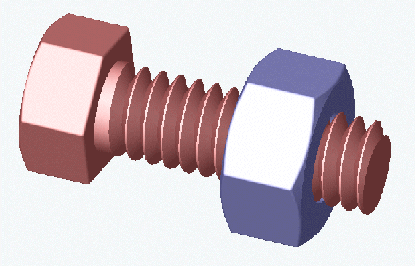

| SimMechanics |   |
Represent a composite joint with one translational DoF and one rotational DoF, with parallel translation and rotation axes and a linear pitch constraint between translational and rotational motion
Library
Description
The Screw block represents a composite joint with one translational degree of freedom (DoF) as one prismatic primitive and one rotational DoF as one revolute primitive. The translation and rotation axes are parallel. The translational and rotational DoFs are constrained by a pitch constraint to have proportional motion.
You must connect each side of the Joint block to a Body block at a Body coordinate system (CS) point. The Screw block is assembled: the origins of these Body CSs must lie along the primitive axes, and the Body CS origins on either side of the Joint must be spatially collocated points, to within assembly tolerances.
You can connect any Joint block to two and only two Body blocks, and Joints have a default of two Connector Ports for connecting to base and follower Bodies.
A Joint block represents only the abstract relative motion of two bodies, not the bodies themselves. You must specify a reference CS to define the direction of the joint axis.

Dialog Box and Parameters
The dialog box has three active areas, Connection parameters, Parameters, and Pitch parameters.
Connection Parameters
R1 in the primitive list in Parameters.R1 in the primitive list in Parameters.0.The base (B)-follower (F) Body sequence determines the sense of positive motion. Positive rotation is the follower moving around the rotational axis following the right-hand rule.
Screw base and follower Body Connector Ports
Parameters
Toggle between the Axes and Advanced panels with the tabs.
The entries on the Axes pane are required. Each DoF primitive in Screw has an entry line. These lines specify the direction of the axes of action of the DoFs that the Screw represents.
R1.WORLD.The Advanced pane is optional. You use it to control the way SimMechanics interprets the topology of your schematic diagram.
Pitch Parameters
The Pitch parameters control how far the screw translates for each revolution.
 radians (360o). The default is
radians (360o). The default is 1.mm (millimeters).See Also
Cylindrical, Prismatic, Revolute
See Modeling Joints for more on representing DoFs with Joints.
See Checking Schematic Topology and How SimMechanics Works for more on closed loops and cutting.
 | RotationMatrix2VR | Six-DoF |  |